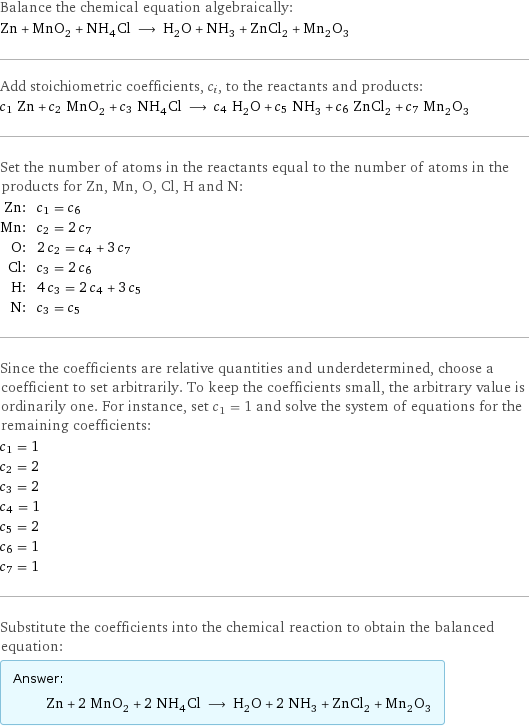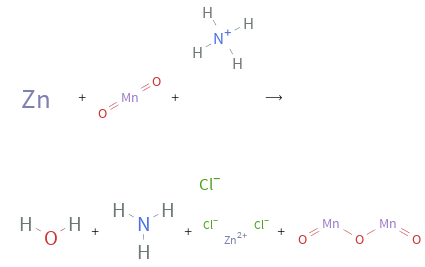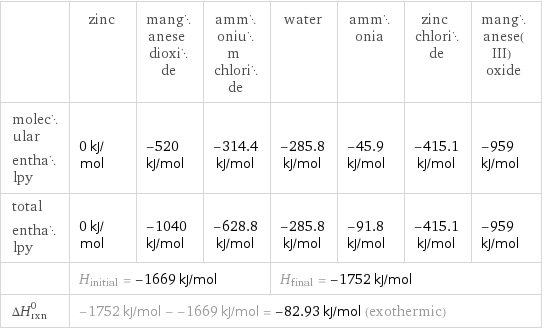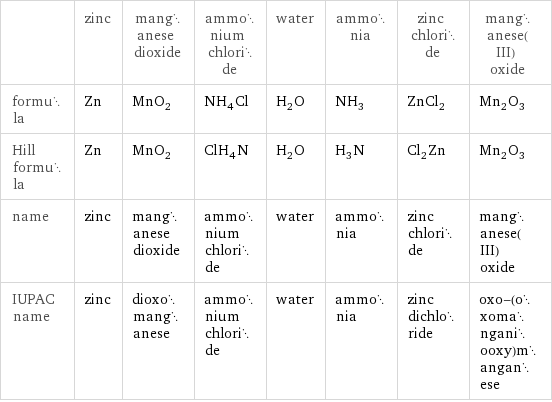Input interpretation

Zn zinc + MnO_2 manganese dioxide + NH_4Cl ammonium chloride ⟶ H_2O water + NH_3 ammonia + ZnCl_2 zinc chloride + Mn_2O_3 manganese(III) oxide
Balanced equation

Balance the chemical equation algebraically: Zn + MnO_2 + NH_4Cl ⟶ H_2O + NH_3 + ZnCl_2 + Mn_2O_3 Add stoichiometric coefficients, c_i, to the reactants and products: c_1 Zn + c_2 MnO_2 + c_3 NH_4Cl ⟶ c_4 H_2O + c_5 NH_3 + c_6 ZnCl_2 + c_7 Mn_2O_3 Set the number of atoms in the reactants equal to the number of atoms in the products for Zn, Mn, O, Cl, H and N: Zn: | c_1 = c_6 Mn: | c_2 = 2 c_7 O: | 2 c_2 = c_4 + 3 c_7 Cl: | c_3 = 2 c_6 H: | 4 c_3 = 2 c_4 + 3 c_5 N: | c_3 = c_5 Since the coefficients are relative quantities and underdetermined, choose a coefficient to set arbitrarily. To keep the coefficients small, the arbitrary value is ordinarily one. For instance, set c_1 = 1 and solve the system of equations for the remaining coefficients: c_1 = 1 c_2 = 2 c_3 = 2 c_4 = 1 c_5 = 2 c_6 = 1 c_7 = 1 Substitute the coefficients into the chemical reaction to obtain the balanced equation: Answer: | | Zn + 2 MnO_2 + 2 NH_4Cl ⟶ H_2O + 2 NH_3 + ZnCl_2 + Mn_2O_3
Structures

+ + ⟶ + + +
Names

zinc + manganese dioxide + ammonium chloride ⟶ water + ammonia + zinc chloride + manganese(III) oxide
Reaction thermodynamics
Enthalpy

| zinc | manganese dioxide | ammonium chloride | water | ammonia | zinc chloride | manganese(III) oxide molecular enthalpy | 0 kJ/mol | -520 kJ/mol | -314.4 kJ/mol | -285.8 kJ/mol | -45.9 kJ/mol | -415.1 kJ/mol | -959 kJ/mol total enthalpy | 0 kJ/mol | -1040 kJ/mol | -628.8 kJ/mol | -285.8 kJ/mol | -91.8 kJ/mol | -415.1 kJ/mol | -959 kJ/mol | H_initial = -1669 kJ/mol | | | H_final = -1752 kJ/mol | | | ΔH_rxn^0 | -1752 kJ/mol - -1669 kJ/mol = -82.93 kJ/mol (exothermic) | | | | | |
Equilibrium constant
![Construct the equilibrium constant, K, expression for: Zn + MnO_2 + NH_4Cl ⟶ H_2O + NH_3 + ZnCl_2 + Mn_2O_3 Plan: • Balance the chemical equation. • Determine the stoichiometric numbers. • Assemble the activity expression for each chemical species. • Use the activity expressions to build the equilibrium constant expression. Write the balanced chemical equation: Zn + 2 MnO_2 + 2 NH_4Cl ⟶ H_2O + 2 NH_3 + ZnCl_2 + Mn_2O_3 Assign stoichiometric numbers, ν_i, using the stoichiometric coefficients, c_i, from the balanced chemical equation in the following manner: ν_i = -c_i for reactants and ν_i = c_i for products: chemical species | c_i | ν_i Zn | 1 | -1 MnO_2 | 2 | -2 NH_4Cl | 2 | -2 H_2O | 1 | 1 NH_3 | 2 | 2 ZnCl_2 | 1 | 1 Mn_2O_3 | 1 | 1 Assemble the activity expressions accounting for the state of matter and ν_i: chemical species | c_i | ν_i | activity expression Zn | 1 | -1 | ([Zn])^(-1) MnO_2 | 2 | -2 | ([MnO2])^(-2) NH_4Cl | 2 | -2 | ([NH4Cl])^(-2) H_2O | 1 | 1 | [H2O] NH_3 | 2 | 2 | ([NH3])^2 ZnCl_2 | 1 | 1 | [ZnCl2] Mn_2O_3 | 1 | 1 | [Mn2O3] The equilibrium constant symbol in the concentration basis is: K_c Mulitply the activity expressions to arrive at the K_c expression: Answer: | | K_c = ([Zn])^(-1) ([MnO2])^(-2) ([NH4Cl])^(-2) [H2O] ([NH3])^2 [ZnCl2] [Mn2O3] = ([H2O] ([NH3])^2 [ZnCl2] [Mn2O3])/([Zn] ([MnO2])^2 ([NH4Cl])^2)](../image_source/96c078d33068731d7135b9c8c585b916.png)
Construct the equilibrium constant, K, expression for: Zn + MnO_2 + NH_4Cl ⟶ H_2O + NH_3 + ZnCl_2 + Mn_2O_3 Plan: • Balance the chemical equation. • Determine the stoichiometric numbers. • Assemble the activity expression for each chemical species. • Use the activity expressions to build the equilibrium constant expression. Write the balanced chemical equation: Zn + 2 MnO_2 + 2 NH_4Cl ⟶ H_2O + 2 NH_3 + ZnCl_2 + Mn_2O_3 Assign stoichiometric numbers, ν_i, using the stoichiometric coefficients, c_i, from the balanced chemical equation in the following manner: ν_i = -c_i for reactants and ν_i = c_i for products: chemical species | c_i | ν_i Zn | 1 | -1 MnO_2 | 2 | -2 NH_4Cl | 2 | -2 H_2O | 1 | 1 NH_3 | 2 | 2 ZnCl_2 | 1 | 1 Mn_2O_3 | 1 | 1 Assemble the activity expressions accounting for the state of matter and ν_i: chemical species | c_i | ν_i | activity expression Zn | 1 | -1 | ([Zn])^(-1) MnO_2 | 2 | -2 | ([MnO2])^(-2) NH_4Cl | 2 | -2 | ([NH4Cl])^(-2) H_2O | 1 | 1 | [H2O] NH_3 | 2 | 2 | ([NH3])^2 ZnCl_2 | 1 | 1 | [ZnCl2] Mn_2O_3 | 1 | 1 | [Mn2O3] The equilibrium constant symbol in the concentration basis is: K_c Mulitply the activity expressions to arrive at the K_c expression: Answer: | | K_c = ([Zn])^(-1) ([MnO2])^(-2) ([NH4Cl])^(-2) [H2O] ([NH3])^2 [ZnCl2] [Mn2O3] = ([H2O] ([NH3])^2 [ZnCl2] [Mn2O3])/([Zn] ([MnO2])^2 ([NH4Cl])^2)
Rate of reaction
![Construct the rate of reaction expression for: Zn + MnO_2 + NH_4Cl ⟶ H_2O + NH_3 + ZnCl_2 + Mn_2O_3 Plan: • Balance the chemical equation. • Determine the stoichiometric numbers. • Assemble the rate term for each chemical species. • Write the rate of reaction expression. Write the balanced chemical equation: Zn + 2 MnO_2 + 2 NH_4Cl ⟶ H_2O + 2 NH_3 + ZnCl_2 + Mn_2O_3 Assign stoichiometric numbers, ν_i, using the stoichiometric coefficients, c_i, from the balanced chemical equation in the following manner: ν_i = -c_i for reactants and ν_i = c_i for products: chemical species | c_i | ν_i Zn | 1 | -1 MnO_2 | 2 | -2 NH_4Cl | 2 | -2 H_2O | 1 | 1 NH_3 | 2 | 2 ZnCl_2 | 1 | 1 Mn_2O_3 | 1 | 1 The rate term for each chemical species, B_i, is 1/ν_i(Δ[B_i])/(Δt) where [B_i] is the amount concentration and t is time: chemical species | c_i | ν_i | rate term Zn | 1 | -1 | -(Δ[Zn])/(Δt) MnO_2 | 2 | -2 | -1/2 (Δ[MnO2])/(Δt) NH_4Cl | 2 | -2 | -1/2 (Δ[NH4Cl])/(Δt) H_2O | 1 | 1 | (Δ[H2O])/(Δt) NH_3 | 2 | 2 | 1/2 (Δ[NH3])/(Δt) ZnCl_2 | 1 | 1 | (Δ[ZnCl2])/(Δt) Mn_2O_3 | 1 | 1 | (Δ[Mn2O3])/(Δt) (for infinitesimal rate of change, replace Δ with d) Set the rate terms equal to each other to arrive at the rate expression: Answer: | | rate = -(Δ[Zn])/(Δt) = -1/2 (Δ[MnO2])/(Δt) = -1/2 (Δ[NH4Cl])/(Δt) = (Δ[H2O])/(Δt) = 1/2 (Δ[NH3])/(Δt) = (Δ[ZnCl2])/(Δt) = (Δ[Mn2O3])/(Δt) (assuming constant volume and no accumulation of intermediates or side products)](../image_source/47ca0be1c2bcb27158bfb0b478d975f8.png)
Construct the rate of reaction expression for: Zn + MnO_2 + NH_4Cl ⟶ H_2O + NH_3 + ZnCl_2 + Mn_2O_3 Plan: • Balance the chemical equation. • Determine the stoichiometric numbers. • Assemble the rate term for each chemical species. • Write the rate of reaction expression. Write the balanced chemical equation: Zn + 2 MnO_2 + 2 NH_4Cl ⟶ H_2O + 2 NH_3 + ZnCl_2 + Mn_2O_3 Assign stoichiometric numbers, ν_i, using the stoichiometric coefficients, c_i, from the balanced chemical equation in the following manner: ν_i = -c_i for reactants and ν_i = c_i for products: chemical species | c_i | ν_i Zn | 1 | -1 MnO_2 | 2 | -2 NH_4Cl | 2 | -2 H_2O | 1 | 1 NH_3 | 2 | 2 ZnCl_2 | 1 | 1 Mn_2O_3 | 1 | 1 The rate term for each chemical species, B_i, is 1/ν_i(Δ[B_i])/(Δt) where [B_i] is the amount concentration and t is time: chemical species | c_i | ν_i | rate term Zn | 1 | -1 | -(Δ[Zn])/(Δt) MnO_2 | 2 | -2 | -1/2 (Δ[MnO2])/(Δt) NH_4Cl | 2 | -2 | -1/2 (Δ[NH4Cl])/(Δt) H_2O | 1 | 1 | (Δ[H2O])/(Δt) NH_3 | 2 | 2 | 1/2 (Δ[NH3])/(Δt) ZnCl_2 | 1 | 1 | (Δ[ZnCl2])/(Δt) Mn_2O_3 | 1 | 1 | (Δ[Mn2O3])/(Δt) (for infinitesimal rate of change, replace Δ with d) Set the rate terms equal to each other to arrive at the rate expression: Answer: | | rate = -(Δ[Zn])/(Δt) = -1/2 (Δ[MnO2])/(Δt) = -1/2 (Δ[NH4Cl])/(Δt) = (Δ[H2O])/(Δt) = 1/2 (Δ[NH3])/(Δt) = (Δ[ZnCl2])/(Δt) = (Δ[Mn2O3])/(Δt) (assuming constant volume and no accumulation of intermediates or side products)
Chemical names and formulas

| zinc | manganese dioxide | ammonium chloride | water | ammonia | zinc chloride | manganese(III) oxide formula | Zn | MnO_2 | NH_4Cl | H_2O | NH_3 | ZnCl_2 | Mn_2O_3 Hill formula | Zn | MnO_2 | ClH_4N | H_2O | H_3N | Cl_2Zn | Mn_2O_3 name | zinc | manganese dioxide | ammonium chloride | water | ammonia | zinc chloride | manganese(III) oxide IUPAC name | zinc | dioxomanganese | ammonium chloride | water | ammonia | zinc dichloride | oxo-(oxomanganiooxy)manganese